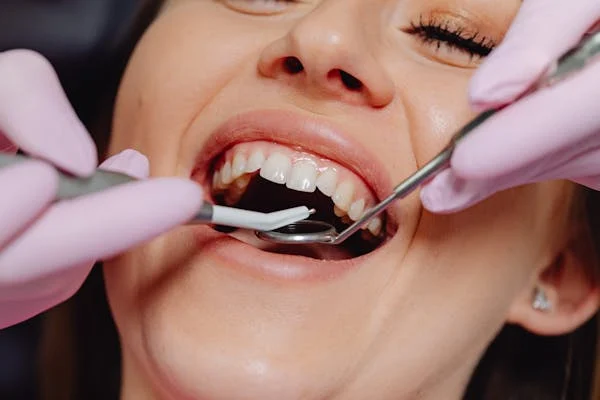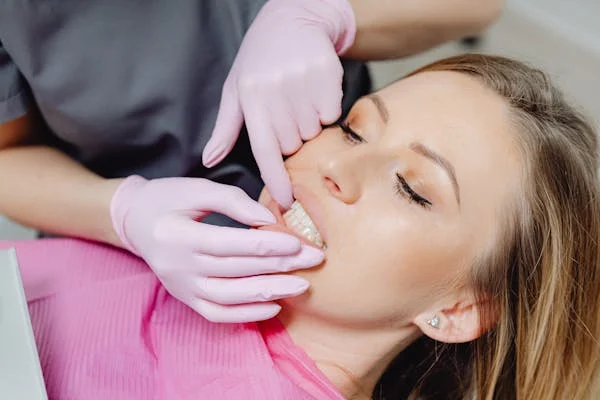
Have you ever noticed sensitive gums, a bit of redness, or slight bleeding when you brush? These can be early signs of gum disease, a silent threat to your oral and overall health.
At Council Oak Perio, we believe understanding is the first step to prevention and effective treatment. Let's explore this common concern and empower you to protect your dental future
Gum disease, or periodontal disease, begins with plaque buildup—a sticky film of bacteria—on your teeth. If not removed, it leads to inflammation, infection, and eventually destruction of the gum and bone that support your teeth.
Healthy gums keep your teeth anchored and protect them from harmful bacteria. Neglecting gum care can lead to tooth loss, bad breath, and even serious systemic health problems.
Nearly half of adults over 30 show signs of gum disease, making it one of the most common oral health issues. Smokers, diabetics, pregnant women, and older adults are especially at risk for developing severe gum infections.
Gum disease progresses in stages, from mild inflammation to severe tissue and bone destruction. Recognizing the stage you're in is essential for determining the appropriate treatment.
Gingivitis is the earliest stage of gum disease, characterized by redness, swelling, and bleeding gums. The good news? It’s reversible with proper oral hygiene and regular cleanings.
In this stage, gums start to pull away from the teeth, forming infected pockets. Without intervention, the supporting bone begins to deteriorate.
This stage involves deep pockets, bone loss, and loose teeth. Advanced periodontitis often requires surgical treatment to restore oral function and prevent further tooth loss.
Understanding the root causes of gum disease can help you prevent it. Most causes relate to bacterial buildup and immune system response.
Inadequate brushing and flossing allow plaque to accumulate and harden into tartar. This leads to chronic inflammation and damage to the gums.
Tobacco use reduces blood flow to gum tissue, making it harder for your body to fight infections. It also masks early signs of gum disease, delaying diagnosis and treatment.
Some people are genetically predisposed to gum disease, even with good oral hygiene. If your parents had periodontal issues, you may be more susceptible.
Hormonal shifts during pregnancy, menopause, or menstruation can increase gum sensitivity and inflammation. Medical conditions like diabetes also raise the risk of developing gum disease.
Some medications cause dry mouth, which reduces saliva and promotes bacterial growth. Others may cause abnormal gum growth, creating pockets where bacteria can thrive.
Early symptoms of gum disease can be subtle but shouldn’t be ignored. Identifying these signs early can help prevent permanent damage.
Bleeding when you brush or floss is often the first visible sign of gum disease. Healthy gums should never bleed during routine oral care.
Inflamed gums may appear puffy and feel tender to the touch. This inflammation is a sign your body is trying to fight off infection.
As gums pull away from the teeth, you may notice your teeth appear longer or feel more sensitive. Recession exposes the tooth root, making it vulnerable to decay and discomfort.
Chronic halitosis can result from bacteria trapped in gum pockets. Even mouthwash may not fully mask the odor caused by infection.
Council Oak Perio’s dentists use several tools to diagnose gum disease accurately. These methods help determine severity and guide treatment decisions.
A small probe measures the depth of the space between your gums and teeth. Deeper pockets usually indicate more advanced disease.
X-rays reveal bone loss that isn’t visible during a visual exam. They’re essential for assessing the extent of damage below the surface.
Pockets greater than 3 mm may signal the onset of periodontitis. Regular measurements help track the progression or improvement of the disease.
Gum disease doesn’t just stay in your mouth—it can impact your entire body. Inflammation caused by periodontal disease is linked to numerous health problems.
Inflammation from gum disease may contribute to plaque buildup in arteries, increasing the risk of heart attacks. Studies have shown a clear connection between poor oral health and cardiovascular problems.
Gum disease can make it harder to control blood sugar levels. Likewise, uncontrolled diabetes can worsen gum infections, creating a dangerous feedback loop.
Pregnant women with untreated gum disease are more likely to deliver prematurely or have underweight babies. Hormonal changes also make gums more susceptible to inflammation during pregnancy.
From deep cleaning to surgery, treatments vary depending on the severity of the disease. Prompt intervention improves outcomes and can even save teeth.
This nonsurgical treatment removes plaque and tartar from beneath the gumline. It smooths root surfaces, helping gums reattach to teeth.
Topical or oral antibiotics may be used to reduce bacterial infection. Antimicrobial mouth rinses help keep bacterial levels down during recovery.
In severe cases, surgery is needed to reduce pocket depth or repair damaged gum tissue. Gum grafts can restore lost gumline and protect exposed roots.
Lasers target and destroy infected tissue with minimal discomfort. This modern treatment promotes faster healing and less bleeding than traditional surgery.
Good oral hygiene and lifestyle choices play a major role in prevention. Staying ahead of the disease is easier—and less painful—than treating it later.
Brush twice a day and floss at least once to remove plaque and food debris. Consistency is key in preventing gum disease.
Seeing your dentist regularly helps detect early signs of gum disease. Professional cleanings also remove tartar that brushing alone can’t.
Nutrients like vitamin C and calcium support gum health. Drinking water helps flush away bacteria and keeps your mouth hydrated.
Tobacco use significantly increases your risk of gum disease. Quitting improves your gum health and overall wellness.
While genetics play a role, many risk factors are lifestyle-based. Being proactive can dramatically reduce your chances of developing gum disease.
Chronic stress weakens the immune system, making it harder to fight infections. Reducing stress helps your body better defend against gum disease.
Poor brushing technique, sugary snacks, and teeth grinding all contribute to gum damage. Improving your oral habits makes a big difference in prevention.
Although more common in adults, gum disease can also affect younger individuals. Early education and dental visits help prevent long-term issues.
Pediatric dentists look for warning signs like gingivitis during routine checkups. Treating these early issues ensures a healthy start for your child’s oral health.
Puberty can trigger increased gum sensitivity and swelling. Teens need extra encouragement to maintain good oral hygiene habits.
Beyond health implications, gum disease affects how your smile looks. Aesthetic concerns often accompany advanced periodontal issues.
Receding gums can make teeth look too long or uneven. This not only affects appearance but also exposes roots to sensitivity and decay.
Missing teeth from gum disease can lead to bite problems and facial sagging. Tooth replacement becomes necessary to restore both function and aesthetics.
Recovery doesn’t end after treatment—ongoing care is essential. Good habits ensure the disease doesn’t return.
Mild soreness or sensitivity is common after deep cleaning. Stick to soft foods and rinse with warm saltwater to ease discomfort.
Your dentist will schedule follow-ups to monitor progress and prevent relapse. Skipping these visits can undo all your hard work.
Custom maintenance plans often include more frequent cleanings and special at-home care. These plans help manage chronic gum disease effectively.
Thinking about dental implants? Gum health plays a major role in your eligibility.
You may still qualify, but only after active infection is treated. Bone grafts may be required if significant bone loss has occurred.
Even artificial teeth need a healthy foundation. Regular checkups and cleanings are vital to implant success.

Council Oak Perio in Austin, TX, is your trusted destination for advanced periodontal services. Led by Dr. Christopher Bingham, we specialize in treating all stages of gum disease and restoring your oral health.
From deep cleanings and gum grafts to cosmetic reshaping and laser therapy, our team is committed to helping you smile confidently again. Conveniently located at 711 W. 38th Street, Suite G5, we’re open Monday–Thursday from 7:30 AM to 3:30 PM—let us help you reclaim your gum health!
Gum disease is sneaky... but not unbeatable. The earlier you recognize the signs, the easier it is to treat. Whether you're in the early stages of gingivitis or facing advanced periodontitis, there’s always a path forward.
Trust in prevention, stay vigilant, and lean on expert care from Council Oak Perio for lasting results.
No, untreated gum disease typically worsens over time and needs professional care.
While not contagious in the traditional sense, bacteria can be transferred between people.
Early-stage gingivitis may be reversed with improved hygiene, but advanced stages need dental intervention.
Every 3–4 months is often recommended, but your provider will tailor the schedule to your needs.
Yes, once gum tissue recedes, it won’t grow back naturally. However, grafting procedures can restore your gumline.